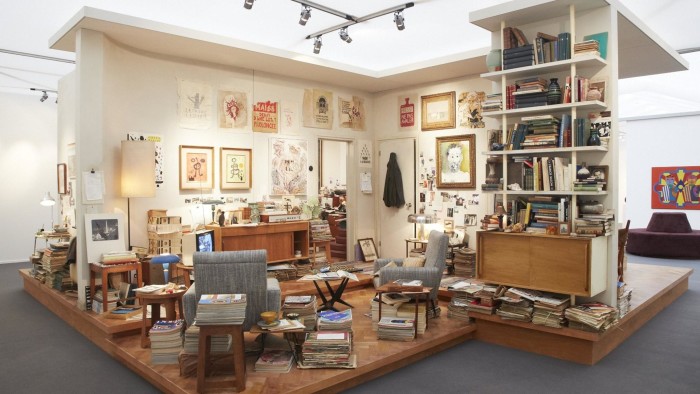Frieze Art Fair: the best piece of theatre in town

Simply sign up to the Life & Arts myFT Digest -- delivered directly to your inbox.
Moments into the preview of Frieze Masters, I collided with Munich gallerist Georg Laue in “The Collector”, Helly Nahmad gallery’s spectacular immersive installation recreating a Paris apartment in 1968. I was admiring a Giacometti “Trois Hommes qui marchent I” that functioned as an alternative bedside table, a graffiti-ish portrait of Picasso’s chauffeur as Homeric hero, “Buste d’homme barbu”, across from a sink piled high with dirty dishes, and a sparkling white slashed Lucio Fontana “Concetto spaziale, Attese” above a cluttered desk. Laue, among piles of art magazines, gallery receipts pegged to walls, ashtrays beneath a burnt Alberto Burri canvas, was marvelling at the installation’s authenticity and detail: as a dealer, he said, he visits elderly clients in just such wonderfully haphazard apartments.
Those interiors are entirely unexpected at Frieze. Yet so intoxicating is Nahmad’s stand, with evocative soundtracks – Miles Davis, Nino Rota’s whimsical, ragged score for La Dolce Vita – and small televisions playing Godard, Truffaut, the French Winter Olympics, clips of the Paris riots, that with one nostalgic, bohemian gust it blows away the precious, pristine, smartly labelled art fair piety of everything else at Regent’s Park.
Nahmad proposes an imaginary “journey through one man’s life and spirit . . . a diary so intimate and personal, the collection is a mirror of the man. It calls into question what collecting really means in today’s world.” A challenge to investment-obsessed, herd-like visitors, then – although Nahmad’s 1968 collector has tastes that converge fortunately with 2014 market strengths: Italian postwar art and late Picasso are soaring sectors; Giacometti’s “L’Homme qui marche” is the world’s most expensive sculpture. Nevertheless, while nipping at the hands that feed him, Nahmad brilliantly and wittily hits the nerve centre of this year’s fair: the gallery-booth itself as a piece of performance art, selling as seductive installation.
“Does This Soup Taste Ambivalent?” ask United Brothers (Tomoo and Ei Arakawa, Green Tea Gallery), offering visitors vegetables grown in Fukushima, scene of 2011’s nuclear disaster. At market level, risk and equivocation are the ingredients of the global broth of Frieze itself: how can this slick successful brand reinvent itself to stay fresh, piquant, but also blue-chip?
In spirit as well as in new shared design – comfortable grey carpets throughout, spacious aisles, open feel – the two fairs converge this year into a more homogenised act high on playful curation and performance, with Masters’ historical focus slipping over to the better parts of Frieze London (which houses works after the year 2000). Even the new section Frieze Live includes vintage kinetic pieces such as Robert Breer’s “Floats” (1970), disorienting self-propelling white domes that make you feel you are moving even when motionless.
Galleries seize the performance baton without missing a beat. A double whammy from Hauser & Wirth has superb early kinetic sculptures by Jean Tinguely and an inspired evocation of Sigmund Freud’s Hampstead home – wooden floors, rich fabrics, antiques – in “A Study in Red and Green”, curated by Mark Wallinger. This is the intellectual highlight of Frieze London: in colour zones representing conscious and unconscious minds, Wallinger harmonises in a psychologically engrossing setting works as varied as Louise Bourgeois’s hysterical “Arched Figure”, Rashid Johnson’s zebra daybed, Guillermo Kuitca’s abstraction “People on Fire”.
At Lisson, staff kitted out in Ryan Gander’s customised Adidas trainers are selling Cory Arcangel’s “Surfware” in what feels like a shopping mall. Oscar Murillo’s chocolate factory, for which the artist imported Colombians to work in a New York gallery, is recreated with chocolate-coated tennis and golf ball sculptures – over-consumption meets elitist sports – and as a whirr of product lines, gaming, dancing, spinning, in the artist’s fluid, immersive video diary of the project at David Zwirner. At Gagosian, Carsten Höller’s “Gartenkinder” is a children’s playground with crawl-in giant dice, rocking mushroom, a “Perplexity Ball” bouncing unpredictably.
Mock-improvisation at Frieze London gives way to supremely refined tuning at Frieze Masters, where still the idea is for an ambitious booth to look like anything but an art fair stand. Georg Laue’s Kunstkammer has teamed with New York’s Peter Freeman to create a stunning old/new “Wunderkammer”: Renaissance Venetian glass alongside abstract Gerhard Richter; Alexander Calder’s painted metal “Seven Legged Beast” and a 19th-century walrus skull.
“Rumble in the Jungle”, Thomas Dane’s and Corbett vs Dempsey’s joint venture, conjures a highly sexualised 1974 art fair: Philip King’s “Barbarian Fruit”, Jim Nutt’s painted fried breakfast revolving into male genitalia, Lynda Benglis’s feminist nudes, plus memorabilia such as a poster for George Foreman vs Muhammad Ali.
At the other extreme, Thomas Gibson’s dazzling French paintings and sculpture – Delacroix, a Gauguin Tahitian watercolour, Maillol, Léger’s gouache study for “La Grande Parade” – all from the Texan private Long Collection, are displayed as if lifted straight from a refined collector’s home.
What is authentic, what performative? We take for granted this fair’s impressive solo works and presentations – Rembrandt, Rubens, David Smith, Francis Bacon – though there are still too few surprises or challenges to fashion. Rather, Frieze 2014 has condensed the global, multi-billion-dollar art world into a self-enthralled meta-text about selling and collecting. It doesn’t feel real. It is the best piece of theatre in town.
Frieze London runs to Saturday; Frieze Masters ends on Sunday, frieze.com
Comments